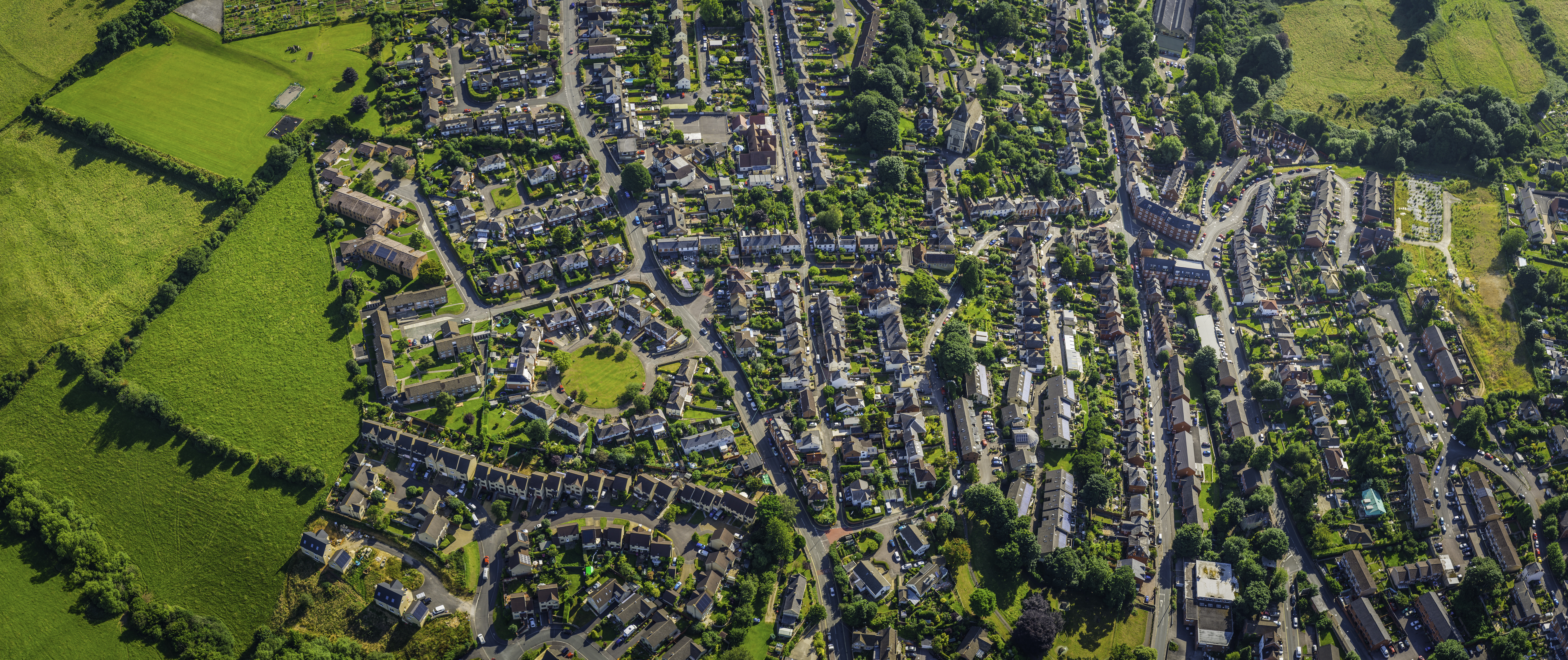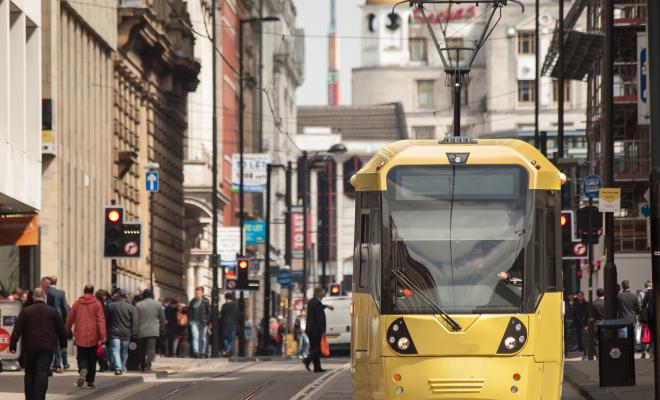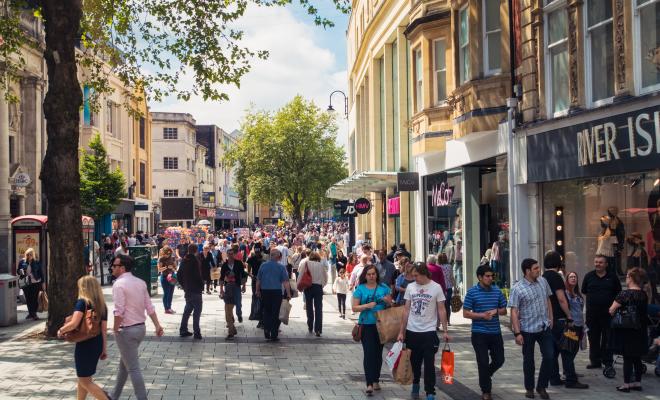20 Sep 2024
How is Action 28 tackling the climate crisis?
As vehicles contribute significantly to carbon emissions and climate breakdown, local authorities can make sure new developments reduce the need for personal vehicles and encourage active travel or public transport, through clever planning.
Stroud District Council is reducing car journeys using a settlement hierarchy – a planning tool that aims to keep homes, jobs and services as close together as possible so that people’s daily needs are met on their doorstep. The hierarchy will also make sure developments support new infrastructure for sustainable travel, such as walking and cycling.
Stroud District is comprised of market towns and rural communities. Car use is high:
- 86% of people own at least one car
- 75% of commuters travel to work by car (higher than the UK average of 62%)
- 27% of people travel less than 5km to work, two-thirds of them going by car
Stroud District Council is discouraging car use at a strategic planning and development level by putting their settlement hierarchy at the heart of the council’s Local Plan, due to be formally adopted by autumn 2022.
Understanding the roles of different towns and villages has helped Stroud District Council take steps to cut car use, recognising that the location of communities is a major driver of commuter behaviour. Settlement hierarchies concentrate new building developments in the most sustainable and accessible places, and restrict them elsewhere, in order to create self-contained settlements where people’s daily needs are met close to their home, reducing the need to travel long distances via car.
Stroud’s hierarchy works by ranking the district’s towns and villages against a range of criteria relative to each other. These include size, access to services and facilities, employment role and economic activity, and retail provision. This information reveals each place’s unique role and function, where it’s sorted into one of four tiers:
Tier 1: large settlements such as Stroud.
Tier 2: market towns and large villages that are local service centres and can support modest housing and employment.
Tier 3: places with moderate local facilities, typically large to medium-sized villages. This tier is split into subcategories depending on their accessibility and connectivity to higher tiers.
Tier 4: settlements with only basic facilities, normally small or very small villages. This tier is also split into subcategories dependent on accessibility.
Guided by the settlement hierarchy, Stroud’s Local Plan dictates that proposals for new homes or workplaces will be granted only if they're readily accessible by public transport, bike, or foot. If this isn’t possible, proposals must contribute to new infrastructure which improves the accessibility of proposed developments by bus or active travel. Therefore, all proposals are obliged to discourage car usage. This is an attitude towards planning which is proactive rather than passively reactive to developer demands.
Stroud District Council is also integrating its Local Plan with its Sustainable Transport Strategy. This prioritises walking, cycling, public transport, car-sharing and taxis, and then cars – in that order. Interventions include improving the region’s bus services, segregated cycle routes, railway improvements and the promotion of mobility-as-a-service, encouraging people to have occasional access to vehicles rather than ownership as the default.
Together, Stroud’s strategic settlement hierarchy and its ambitious Sustainable Transport Strategy aims to reduce car ownership while maintaining personal mobility in a challenging rural setting.
What impact has the project had?
It’s too soon to be able to measure the impact of the hierarchy, but the council’s vision for sustainable transport is clear. Its aims include:
- 90% of commuters who are currently travelling less than 5km to work via car will use public or active transport instead
- Travel by train to be 50% increased from 2010/11 figures, by 2030
- By 2030 the district’s main town centres will be car-free (except resident vehicles).
The following improvements have already been delivered:
- 5.5 miles of new accessible multi-use active travel paths, which are used by 250,000 people a year, with further extensions to the network on the way
- Since August 2021, cheaper, expanded and more frequent bus travel across the district from Stagecoach West, the area’s main bus operator
The settlement hierarchy helps the council apply the district-level Local Plan to micro-level issues and challenges. For example, villages and towns with ageing populations and few children, such as Minchinhampton, often complain about school-related traffic. This situation arises when village schools are undersubscribed from within the local community, causing children to travel from elsewhere. A settlement hierarchy can identify this kind of issue and find solutions.
A new Eco Village
The 2022 Local Plan will include the development of Sharpness Eco Village, a new settlement to be built following garden city principles – the aim is to create a beautiful, healthy, and connected community that enhances and is integrated with the natural environment. Sharpness will be a self-contained settlement with 5,000 new homes, a 10-hectare business park, 13.5 hectares of new wood planting and a new rail link to Cam. By making walking and cycling the default modes of transport for residents, Sharpness will create a more attractive commuter culture, drastically reducing the need for car journeys.
What made this work?
Siloed policies in areas like retail, health or transport obstruct joined-up approaches. The Local Plan prioritises the climate emergency and is designed to work closely with the district’s sustainable transport strategy, making more effective policy. For example, the transport strategy identified key movement corridors in the district. This knowledge was then used in the Local Plan to identify opportunities to minimise private car use.
Policies need to work in the local context
The settlement hierarchy as a tool is suited to the unique features of the district. Stroud has a range of different-sized settlements, from market towns to hamlets, but no major urban area. This made it hard to follow a traditional route of sorting places into the simplistic categories of ‘major’ or ‘minor’. A more detailed hierarchy was needed to assess how the varied types of settlements interacted with each other, recognising that different planning interventions would be needed in different places.
Using existing processes to bring about change
Stroud’s approach is an example of working smarter, not harder. Updating the Local Plan regularly is a statutory requirement for all councils. The authority has used a compulsory process to pursue the goal of reducing car ownership, at no extra cost. This work builds on previous proven success – the settlement hierarchy was first featured in the 2015 Local Plan. The council was therefore not working from scratch in preparing its latest version, simply updating the older version – and aligning its policies with its declaration of a climate emergency.
Recognising co-benefits
This is not only about cutting emissions. The council wants to make Stroud more accessible for all. In particular, it hopes the expanded travel provision entailed in discouraging car use will help retain young people. Stroud is an ageing district and there’s an exodus of young people. Reducing this outflow of talent and potential is a major incentive for making Stroud more interconnected. In July 2021, the council launched a survey seeking the views of 10 to 25-year-olds on their travel needs.
The opportunity for green recovery
Coronavirus lockdowns have given people a greater sense of place and appreciation for their local surroundings in Stroud. People have got a taste of life with lower car use, and cycling and walking are on the rise, though pressures on recreational spaces have increased, too. All councils have the chance to use the localism induced by coronavirus and increased levels of home working as a springboard for reducing car ownership and achieving other green priorities.
Working with local grassroots
Stroud has also benefitted from enthusiastic grassroots organisations pushing an agenda that complements the council’s own. These include Transition Stroud Transport - a campaign group that aims to improve bus services in and around Stroud, and Stroud Active is a group that takes inspiration from the cycling culture in the Netherlands and other European countries. In February 2021, Stroud Active undertook its own survey to find out what factors would encourage local people to cycle more.
What resources were needed?
The costs for developing and updating the settlement hierarchy were included in the ordinary Local Plan budget. Stroud also benefitted from the Inform Gloucestershire database run by Gloucestershire County Council. The council was able to draw on existing data to draw up a character profile for each settlement. Other councils may not have the benefit of free access to similar data resources, which might incur costs.
In December 2020, a new investment into cycling, walking and rail was approved by Stroud District Council. £282,000 raised through the Community Infrastructure Levy was match-funded by the council, adding an extra £205,000. In February 2021, a further £200,000 was allocated by the council for cycleway, bridge and highway renovations.
Lessons from Stroud
For many, access to a car offers significant freedom and independence. Making a convincing case that public transport and active travel will retain these advantages and will not worsen inequality may be tricky.
Objections to the proposed Sharpness Eco Village have been raised. Throughout June and July 2021, residents organised guided walks in protest of the Local Plan to highlight the extent of open landscape that will be transformed into a housing development. To these residents, the benefits of creating a non-car dependent community do not outweigh the impact of entirely new development on the local area.
Stroud district has several physical factors which complicate planning decisions. Stroud’s topography is hilly and rural, which will increase the cost of the new public transport infrastructure.
Also, any walk or cycle routes must be well thought out, preferably to be as low-effort for users as possible otherwise, public take-up will be low. Two-thirds of the district is an Area of Outstanding Natural Beauty, whilst the remaining third has flood risk associated with the River Severn. On top of this, bottlenecks are created by the M5, A417, A419 and the Bristol-Birmingham rail line. All these factors have shaped the review of the Local Plan.
“Looking through the eyes of communities and settlements is a useful way of focusing strategy. Often big studies or Local Plans seem amorphous and difficult to grasp, but when you think about how transport, healthcare, recreation, green spaces and so on are affecting communities, it becomes clearer. You can use that information to tailor policy, tweak it, and sustain the things that are good and filter out the things that are failing.”
Natalie Whalley, Senior Planning Strategy Officer at Stroud District Council.
“The key thing for Stroud District Council was embedding sustainability considerations into spatial decision making by examining evidence, making linkages, and pulling together disparate elements within the Local Plan in order to have a broad overview and coherent strategy approach.”
Conrad Moore, Principal Planner at Stroud District Council.
Useful information
Information in this case study was sourced primarily from Stroud District Council’s Draft Local Plan and its Sustainable Transport Strategy. The Settlement Role and Function Study 2018 is a supporting document to the Local Plan and is an instructive resource for policymakers beyond Stroud District Council interested in a Settlement Hierarchy.
Related projects
We've found some examples of other council activity on this topic.
- Cornwall Council’s Climate Emergency Development Plan requires new developments to minimise travel and prioritise walking, cycling and public transport.
Friends of the Earth's view
Stroud council is taking a proactive approach towards cutting the high level of car dependency in its area, by joining up its Local Plan policies, integrating with its transport strategy and prioritising its climate emergency to ensure make new developments don’t lock in more car use.
Friends of the Earth is calling for a strengthened national planning policy (in the National Planning Policy Framework) to be more clearly aligned with the government’s net zero targets – making it unequivocal for councils to require that new development is not located in car-dependent locations.
Such national policy changes will help all councils, but this case study demonstrates that it is already possible to develop strong Local Plan policies and utilise tools such as Settlement Hierarchies to direct new development to sustainable locations. It also demonstrates that when combining this with a transport strategy and prioritisation of transport investment this joined-up approach creates much needed new public transport, cycling and walking routes (Action 21 of the Climate Action Plan).
Friends of the Earth is showcasing specific examples of good practice in tackling climate change, but that doesn’t mean we endorse everything that a council is doing.
This case study was produced by Ashden and Friends of the Earth. Adoption of the policies referred to in this case study has been delayed while the Local Plan Examination continues and could result in changes to the policies described in the case study. Any references to national policy in this case study relate to policy under the previous government and reflect the policy context in which the council was operating at the time.





